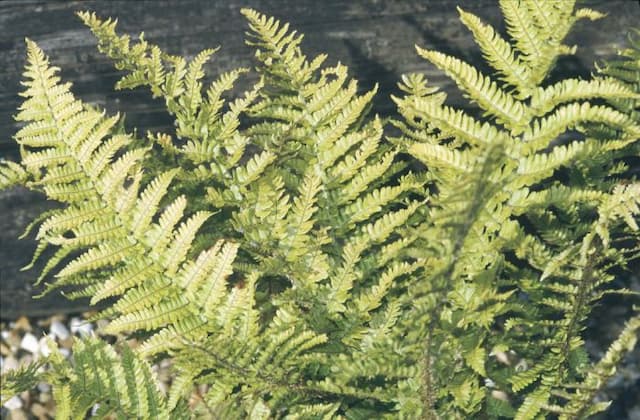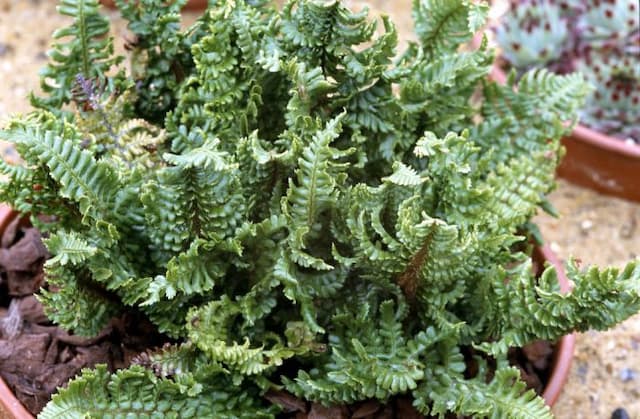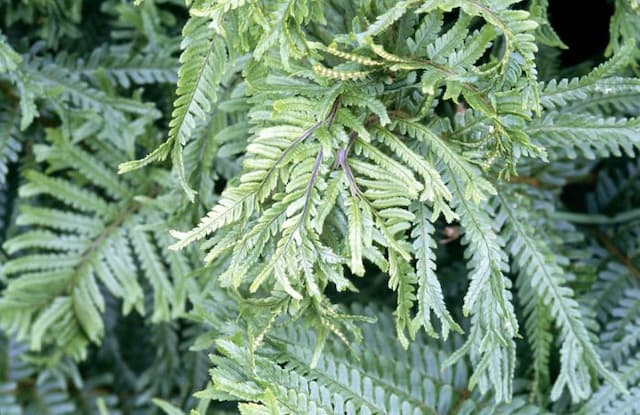Autumn fern Dryopteris erythrosora var. prolifica

ABOUT
Dryopteris erythrosora var. prolifica, commonly known as the autumn fern or Japanese shield fern, is a plant that boasts a striking visual appeal. As it unfurls, the fronds display a captivating range of colors. The young fiddleheads in the springtime emerge with a warm, rusty orange hue that gradually transitions through a spectrum of coppery tones. Over time, as the fronds mature, they adopt a lush green coloration imbued with a glossy sheen. The pinnate leaves, which are subdivided into smaller leaf segments called pinnae, exhibit a delicate and feathery texture. The overall shape of the fronds is lance-like, contributing to a graceful, arching form that adds an element of elegance to the garden. The leaflets are softly serrated and neatly arranged along the frond’s central stem, also known as the rachis, which can sometimes retain a hint of the fronds' earlier reddish coloration. This fern exudes a woodsy and robust aesthetic that is particularly striking when the changing foliage catches the light, highlighting the intricate venation patterns inherent in the leaf structure. The autumn fern creates a visual tapestry of colors and textures, making it a favorite amongst garden enthusiasts for its year-round beauty and serene, naturalistic presence in shaded garden areas.
About this plant
 Names
NamesSynonyms
Autumn Fern, Japanese Wood Fern, Japanese Shield Fern, Copper Shield Fern.
Common names
Aspidium erythrosorum, Nephrodium erythrosorum, Dryopteris prolifica.
 Toxicity
ToxicityTo humans
Autumn fern is not commonly known as a toxic plant to humans. Most ferns, including the autumn fern, are not considered poisonous, but it's generally advisable to avoid ingesting any plant not specifically designated for consumption, as they can cause gastrointestinal discomfort or an allergic reaction in some individuals.
To pets
Autumn fern is not typically listed as toxic to pets such as dogs and cats. However, as with any non-food plant, ingestion can sometimes lead to mild gastrointestinal upset, such as vomiting or diarrhea, especially if the pet is not accustomed to eating such material. If a pet is observed eating autumn fern and shows signs of distress, it is best to consult a veterinarian.
 Characteristics
CharacteristicsLife cycle
Perennials
Foliage type
Evergreen
Color of leaves
Varies
Height
1-2 feet (30-60 cm)
Spread
1-2 feet (30-60 cm)
Plant type
Fern
Hardiness zones
5-9
Native area
East Asia
Benefits
 General Benefits
General Benefits- Aesthetic Appeal: Adds visual interest to gardens with its attractive fronds that change color from copper-red to green.
- Shade Tolerance: Suitable for shaded areas where other plants might struggle to grow.
- Low Maintenance: Requires minimal care once established, making it a good choice for both novice and experienced gardeners.
- Drought Resistance: Can tolerate dry conditions, although it prefers moist soil.
- Cold Hardiness: Resistant to cold temperatures, making it suitable for a variety of climates.
- Wildlife Habitat: Provides shelter and breeding grounds for insects and small wildlife.
- Erosion Control: Its root system can help stabilize soil and prevent erosion, especially on slopes.
 Medical Properties
Medical PropertiesThis plant is not used for medical purposes.
 Air-purifying Qualities
Air-purifying QualitiesThis plant is not specifically known for air purifying qualities.
 Other Uses
Other Uses- Art and Craft: The fronds of the Autumn fern can be pressed and used in botanical prints or framed as natural art due to their unique color and structure.
- Dyeing: Dried fronds of the Autumn fern can be used to extract natural dyes for textile coloring, giving a range of green and brown hues.
- Fairy Gardens: The delicate fronds of Autumn ferns are often incorporated into fairy garden designs to create a whimsical, miniature woodland scene.
- Education: Autumn ferns can be used in schools or educational programs to teach about plant life cycles and spore reproduction.
- Culinary Decoration: While not considered edible, the fronds can be used as a decorative, non-toxic garnish for plating dishes in culinary presentations.
- Mulching Material: Dried Autumn fern fronds can be used as a natural mulching material for garden beds, providing insulation and weed control.
- Photography: Because of their visual appeal, Autumn ferns are sometimes used in photographic compositions for nature photography.
- Themed Landscaping: The Autumn fern can be used in Asian-inspired or woodland-themed gardens to provide aesthetic continuity.
- Erosion Control: The dense rooting system of Autumn ferns can help stabilize soil and prevent erosion on slopes or banks.
- Floristry: Durable fern fronds are sometimes incorporated into floral arrangements to add greenery and texture.
Interesting Facts
 Feng Shui
Feng ShuiThe Autumn fern is not used in Feng Shui practice.
 Zodiac Sign Compitability
Zodiac Sign CompitabilityThe Autumn fern is not used in astrology practice.
 Plant Symbolism
Plant Symbolism- Endurance and Resilience: As a fern, Dryopteris erythrosora var. prolifica, commonly known as the Autumn Fern, can thrive in various conditions, symbolizing the ability to endure and adapt to life's challenges.
- New Beginnings: The unfurling of the fern's new fronds in the spring represents the start of new life or a new chapter, thus symbolizing rebirth and new beginnings.
- Solitude and Secretiveness: Ferns often grow in shaded and secluded areas of the forest, which can symbolize a love for solitude or the keeping of secrets.
- Eternal Youth: The persistent greenery and rejuvenating growth cycle of the Autumn Fern may symbolize eternal youth and the idea of perpetually starting anew.
 Water
WaterThe Autumn Fern should be watered deeply enough to saturate the root zone, which typically means adding about 1-2 inches of water every week. During the growing season in spring and summer, ensure consistent moisture, particularly in dryer periods, by checking the soil moisture regularly and watering when the top inch of soil feels dry. In the fall and winter, reduce watering frequency as the plant’s growth slows down. Avoid overwatering, as this can lead to root rot. It's better to water the plant in the morning to allow excess moisture to evaporate throughout the day.
 Light
LightAutumn Fern prefers indirect, dappled light or partial shade, making it well-suited for a north-facing window or a spot that receives filtered sunlight. Direct, harsh sunlight should be avoided, as it can scorch the delicate fronds of the fern. A location with consistent, bright, indirect light will help the Autumn Fern thrive without the risk of the leaves fading or burning.
 Temperature
TemperatureAutumn Fern thrives in temperatures between 60 and 75 degrees Fahrenheit, making it ideal for most home environments. It can tolerate a minimum temperature down to around 50 degrees Fahrenheit but should not be subjected to temperatures below this, as cold drafts and frost can damage the plant. It's important to shield the Autumn Fern from extreme temperature fluctuations for optimal health.
 Pruning
PruningPruning Autumn Fern is not required for the health of the plant, but it can be done to remove any dead or damaged fronds and to maintain a tidy appearance. The best time to prune is in early spring before new growth begins. Pruning can be performed as needed throughout the growing season to keep the plant looking its best.
 Cleaning
CleaningAs needed
 Soil
SoilAutumn fern prefers moist, well-draining soil rich in organic matter with an acidic to neutral pH, ideally around 5.0 to 7.0. A mix of garden soil, peat, and perlite or sand would be optimal for healthy growth and root development.
 Repotting
RepottingThe autumn fern should be repotted every 2-3 years to refresh the soil mix and prevent it from becoming root-bound. Repotting is best done in spring or early summer.
 Humidity & Misting
Humidity & MistingAutumn fern thrives best in high humidity environments. Aim for a humidity level of 60% or higher for optimal growth conditions.
 Suitable locations
Suitable locationsIndoor
Place in bright, indirect light with high humidity.
Outdoor
Grow in shady area with moist, well-draining soil.
Hardiness zone
5-9 USDA
 Life cycle
Life cycleThe Autumn Fern, Dryopteris erythrosora var. prolifica, begins its life as a spore, which upon finding suitable conditions, germinates to form a small, heart-shaped gametophyte. This gametophyte, through sexual reproduction, gives rise to the sporophyte, the familiar leafy fern we recognize. The sporophyte grows fronds that initially display a striking reddish-bronze color in the spring, maturing to a deep green as they age. As the fern matures, it produces sori on the undersides of the fronds, which are clusters of sporangia containing spores. When the spores are released, they can disperse to new locations to begin the cycle anew. Throughout the perennial life of the Autumn Fern, it continues to expand via vegetative growth and can also reproduce through proliferous fronds, which can root and establish new plants.
 Propogation
PropogationPropogation time
Spring to Summer
The Autumn Fern, Dryopteris erythrosora var. prolifica, is most commonly propagated by division. This process is ideally done in spring, just as new growth begins to appear, providing the plant with a full growing season to establish itself. The method involves gently separating the rhizome, which is the horizontal stem of the plant, into sections ensuring each piece has a portion of the crown and some roots. The divisions can then be planted in a moist, well-drained soil, at the same depth they were growing previously. It's important to water the divisions regularly to keep the soil moist until the new plants are well rooted, usually observed by the initiation of new frond growth.









